Chick fil a breading table – Prepare to dive into the culinary masterpiece that is Chick-fil-A’s breading table, where the magic behind the chain’s iconic crispy chicken unfolds. Step into the realm of culinary precision and innovation, where every component and technique plays a vital role in crafting the perfect bite.
From the carefully selected ingredients to the specialized equipment, the breading table is a symphony of flavors and textures. Join us as we explore the intricate process, revealing the secrets behind Chick-fil-A’s irresistible breading.
Chick-fil-A Breading Table
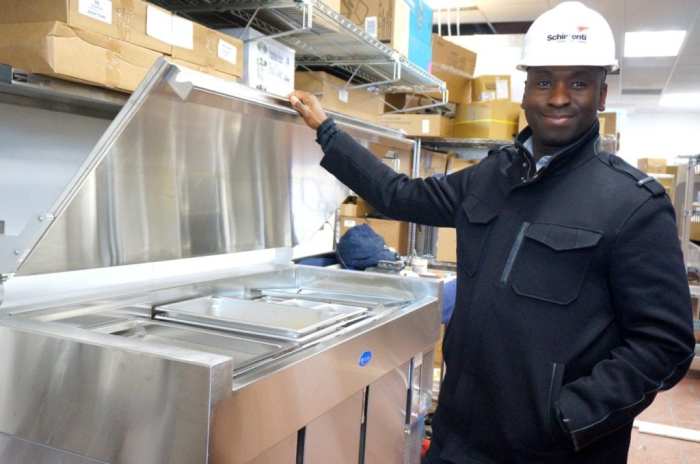
The breading table is a crucial component in Chick-fil-A’s operations, playing a pivotal role in preparing their signature fried chicken. It is designed to efficiently and consistently coat the chicken with the restaurant’s proprietary breading mix, ensuring a crispy and flavorful end product.
Components and Functions
The breading table typically consists of several key components:
- Flour bin:Contains the breading mix, which is a blend of flour, spices, and other ingredients.
- Seasoning station:Where the chicken is seasoned with salt and pepper before being coated in the breading mix.
- Breading machine:A mechanical device that evenly coats the chicken in the breading mix.
- Holding area:Where the breaded chicken is placed before being fried.
Breading Process

The Chick-fil-A breading process is a key factor in the chain’s signature flavor. The process involves several steps, each of which contributes to the unique texture and taste of the chicken.
The first step is to prepare the chicken. The chicken is cut into pieces and then marinated in a special brine solution. The brine helps to tenderize the chicken and also adds flavor. After the chicken has been marinated, it is dredged in a seasoned flour mixture.
The flour mixture helps to create a crispy crust on the chicken.
The next step is to dip the chicken in a buttermilk batter. The buttermilk batter helps to create a moist and flavorful interior. The chicken is then dipped in a second seasoned flour mixture. This second flour mixture helps to create a crispy and golden brown crust.
The final step is to cook the chicken. The chicken is cooked in a pressure fryer. The pressure fryer helps to create a crispy crust and a juicy interior. The chicken is cooked until it is golden brown and cooked through.
Techniques and Methods
The Chick-fil-A breading process uses several techniques and methods to achieve its signature flavor. One technique is the use of a double-breading process. The chicken is first dredged in a seasoned flour mixture, then dipped in a buttermilk batter, and then dredged in a second seasoned flour mixture.
This double-breading process helps to create a crispy and flavorful crust.
Another technique used in the Chick-fil-A breading process is the use of a pressure fryer. The pressure fryer helps to create a crispy crust and a juicy interior. The pressure fryer cooks the chicken at a high temperature and under pressure, which helps to seal in the juices and create a crispy crust.
The Chick-fil-A breading process is a complex and carefully controlled process. The use of a double-breading process and a pressure fryer helps to create the chain’s signature flavor.
Ingredients and Equipment
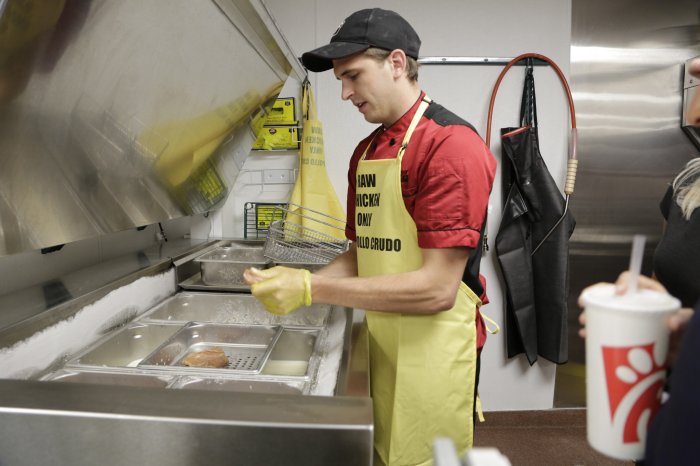
The breading process at Chick-fil-A relies on a combination of carefully selected ingredients and specialized equipment to achieve its signature crispy and flavorful chicken.
The breading mix is a proprietary blend of flour, salt, and pepper, along with a secret blend of spices and herbs. This mixture creates a flavorful and crispy coating that adheres well to the chicken.
Specialized Equipment
The breading table is equipped with specialized equipment that streamlines the breading process and ensures consistency. These include:
- Breading machine:This machine dispenses the breading mix evenly onto the chicken pieces.
- Shaker:The shaker helps remove excess breading from the chicken pieces, creating a thin and even coating.
- Tongs:Tongs are used to handle the chicken pieces throughout the breading process, ensuring they are coated evenly.
Quality Control and Sanitation
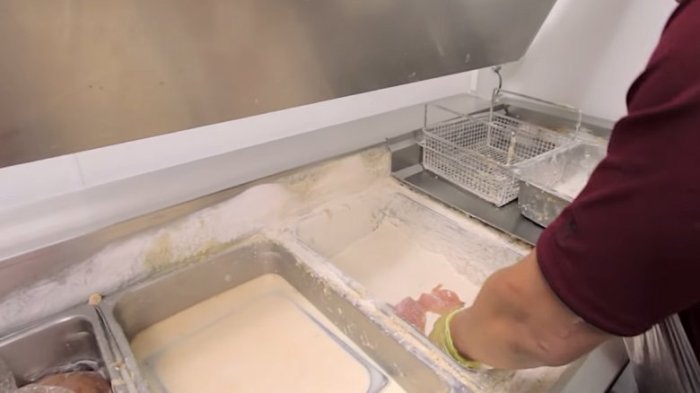
Chick-fil-A implements stringent quality control measures to ensure the consistency and safety of its breaded products. These measures include:
- Raw material inspection:All ingredients used in the breading process are thoroughly inspected upon arrival to ensure they meet the company’s quality standards.
- Regular monitoring of breading equipment:The breading equipment is regularly calibrated and maintained to ensure it operates at optimal conditions.
- Sensory evaluation:Trained quality control personnel conduct sensory evaluations of the breaded products to assess their taste, texture, and appearance.
- Microbiological testing:The breaded products are regularly tested for microbiological contamination to ensure they are safe for consumption.
Sanitation and Hygiene
Chick-fil-A follows strict sanitation and hygiene practices at the breading table to prevent contamination and ensure the safety of its products. These practices include:
- Regular cleaning and sanitizing of equipment:The breading equipment is cleaned and sanitized regularly to prevent the buildup of bacteria and other contaminants.
- Use of gloves and hairnets:Employees working at the breading table are required to wear gloves and hairnets to prevent contamination of the food.
- Regular handwashing:Employees are required to wash their hands frequently to prevent the spread of bacteria.
- Training on food safety:All employees who work at the breading table receive training on food safety practices.
Efficiency and Productivity
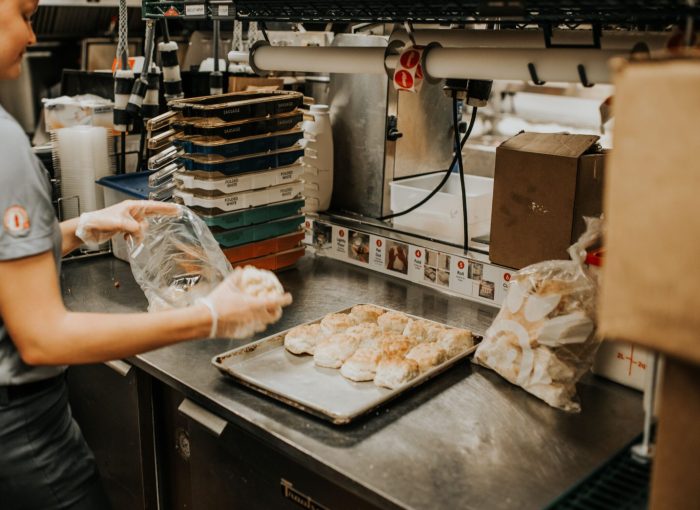
The efficiency and productivity of the breading table are crucial to the overall success of a Chick-fil-A restaurant. Several factors contribute to the smooth operation of the breading table, including:
-
-*Staff training
Well-trained staff members are more efficient and productive, as they have a clear understanding of the breading process and can work quickly and accurately.
-*Equipment maintenance
Properly maintained equipment, such as the breader and conveyor belt, helps to ensure a consistent and efficient breading process.
-*Product quality
Using high-quality ingredients and following the breading process correctly helps to produce delicious and visually appealing chicken products.
Potential improvements and optimizations to enhance the efficiency and productivity of the breading table include:
-
-*Streamlining the breading process
By optimizing the layout of the breading table and the flow of chicken products, restaurants can reduce the time it takes to bread each piece of chicken.
-*Investing in automation
Automated breading machines can help to increase productivity and consistency, freeing up staff members to focus on other tasks.
-*Continuous improvement
Regularly monitoring the breading process and making small adjustments can help to identify and eliminate inefficiencies, leading to increased productivity over time.
Impact of Training
Training is essential for improving the efficiency and productivity of the breading table. Well-trained staff members are able to:
-
-*Follow the breading process correctly
This helps to ensure that the chicken is properly coated and cooked, reducing waste and improving product quality.
-*Work quickly and accurately
Trained staff members can quickly and accurately bread chicken, which helps to increase productivity and reduce wait times for customers.
-*Identify and resolve problems
Trained staff members are better equipped to identify and resolve problems that may arise during the breading process, such as equipment malfunctions or product quality issues.
Importance of Equipment Maintenance
Properly maintained equipment is essential for the efficient and productive operation of the breading table. Regular maintenance helps to prevent breakdowns and ensures that the equipment is operating at peak performance. Some key equipment maintenance tasks include:
-
-*Cleaning and sanitizing the breader and conveyor belt
This helps to prevent the buildup of bacteria and other contaminants, which can affect the quality of the chicken products.
-*Inspecting and calibrating the breader
This helps to ensure that the breader is applying the correct amount of breading to the chicken, which is essential for product quality and consistency.
-*Replacing worn or damaged parts
Worn or damaged parts can affect the performance of the equipment and lead to breakdowns, so it is important to replace them promptly.
Role of Product Quality
Using high-quality ingredients and following the breading process correctly are essential for producing delicious and visually appealing chicken products. High-quality ingredients help to ensure that the chicken is tender and juicy, while following the breading process correctly helps to create a crispy and flavorful coating.
Some key factors that affect product quality include:
-
-*The quality of the chicken
Using high-quality chicken that is free of defects and has a good texture is essential for producing delicious chicken products.
-*The breading mix
Have you ever wondered about the secrets behind the crispy and juicy chicken at Chick-fil-A? Their breading table is the key! Its unique blend of spices and ingredients creates that irresistible flavor. Speaking of tests, if you’re preparing for the HESI Test Bank Med Surg, you’ll find plenty of resources here . Once you’ve mastered the medical knowledge, come back to Chick-fil-A and enjoy their delicious chicken, made possible by their exceptional breading table.
The breading mix should be made from high-quality ingredients and should be properly seasoned to enhance the flavor of the chicken.
-*The breading process
The chicken should be properly coated with the breading mix and cooked to the correct temperature to ensure that it is cooked through and has a crispy coating.
Historical Significance and Evolution: Chick Fil A Breading Table
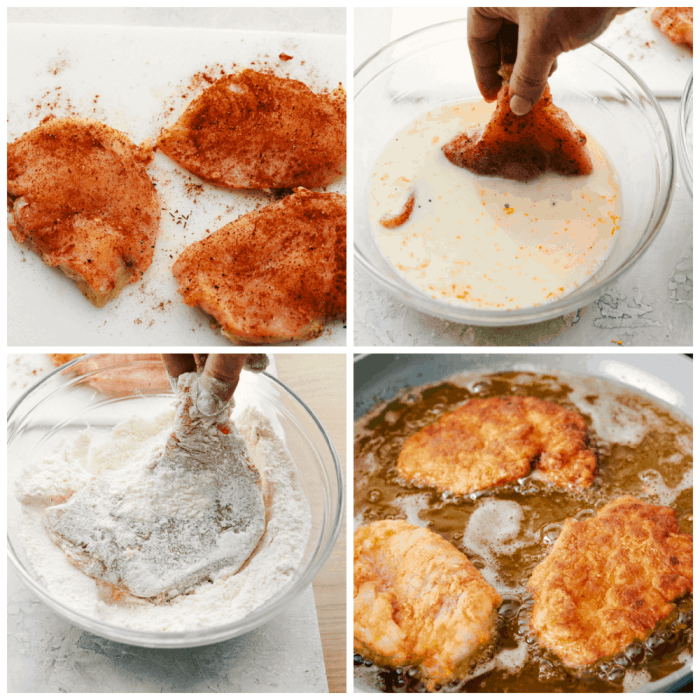
The Chick-fil-A breading table has undergone significant evolution since its inception. Initially, the table was a simple wooden structure used to apply breading to chicken by hand. Over time, the table has been redesigned and modernized to meet the growing demands of the restaurant chain.
One of the key changes to the breading table was the introduction of a conveyor belt system. This system allowed for a more efficient and consistent application of breading, resulting in a more uniform product. Additionally, the conveyor belt system reduced the amount of labor required to bread the chicken, freeing up employees for other tasks.
Technological Advancements, Chick fil a breading table
- The breading table has also seen the incorporation of various technological advancements, such as automated breading machines and computerized controls. These advancements have further improved the efficiency and consistency of the breading process, ensuring that each piece of chicken is coated with the perfect amount of breading.
- The use of digital temperature controls has also been implemented to maintain the optimal temperature of the breading mixture, ensuring that the chicken is cooked to perfection.
Answers to Common Questions
What is the purpose of the breading table at Chick-fil-A?
The breading table is the central hub where Chick-fil-A’s signature chicken is coated in a flavorful breading, creating the crispy and tender texture that has become synonymous with the brand.
What are the key ingredients used in Chick-fil-A’s breading?
The breading recipe is a closely guarded secret, but it is believed to include a blend of flour, salt, pepper, and paprika.
How does Chick-fil-A ensure the consistency of its breading?
Chick-fil-A has strict quality control measures in place to ensure that every piece of chicken is breaded to perfection. This includes regular monitoring of the breading mix and the use of specialized equipment.